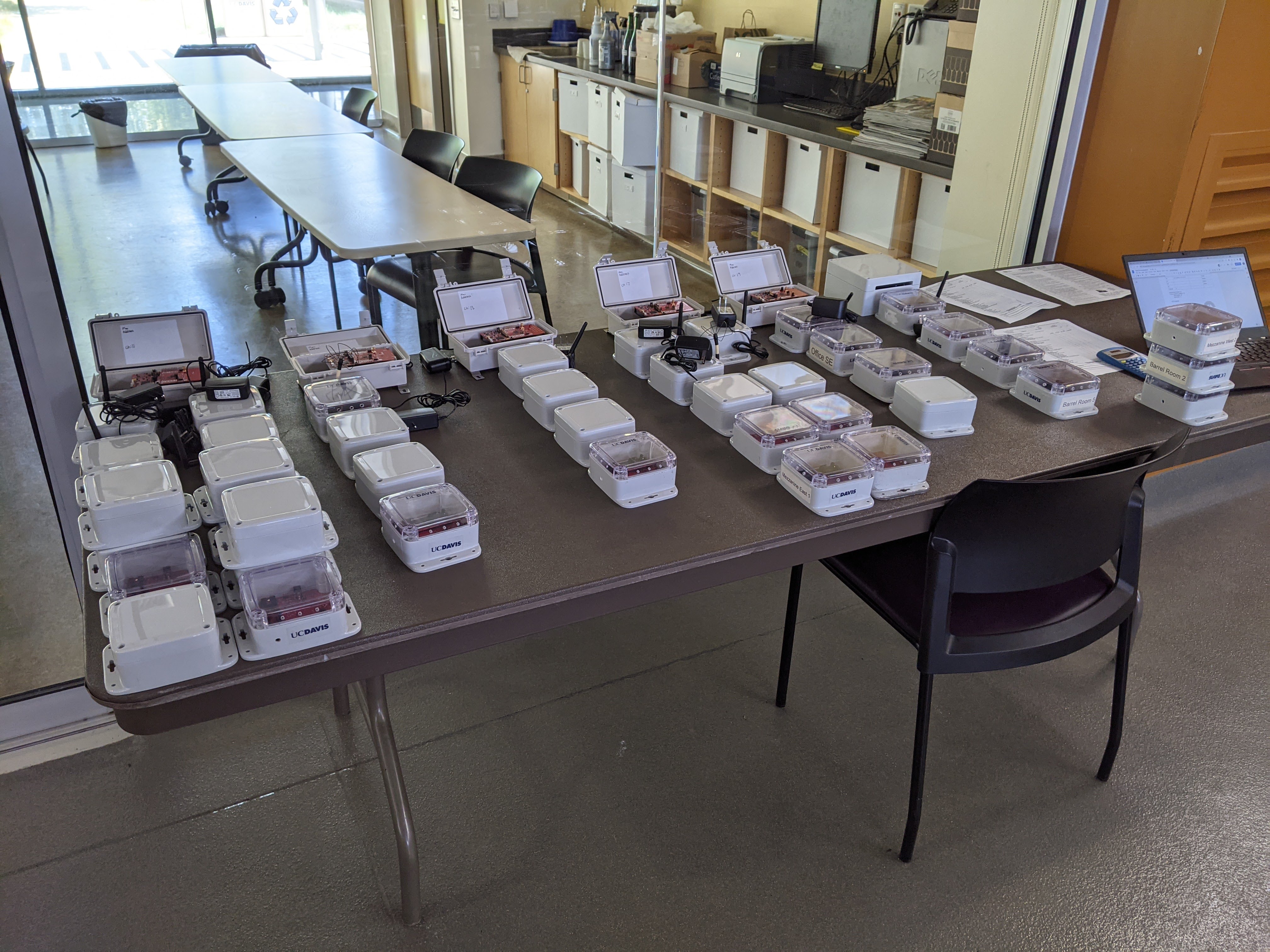Environmental Monitoring of a Winery Environment
Published:

Published in ASEV, 2020
The changes in density and weight loss of juice during a 1500 L wine fermentation were measured using several pressure transducers. The influence of the sensor precision, the vertical separation of the transducers and the ambient temperature and pressure variation on the measurements were investigated and compared with density of samples using a hand-held densitometer. The effect of data smoothing across short and long time-domains was investigated. The transducer measurements were in agreement with the manual measurements.
Recommended citation: James Nelson, Andre Knoesen, Roger Boulton, ASEV 2020
Published in IEEE Topical Conference on Wireless Sensors and Sensor Networks (WiSNeT), 2021
Existing CO2 monitoring devices for wineries typically consist of a single sensor mounted on the wall, providing only a point measurement, however, the spatial dependency of CO2 lends itself to a multi-sensor system…
Recommended citation: J. Nelson et al., "Wireless Sensor Network with Mesh Topology for Carbon Dioxide Monitoring in a Winery," 2021 IEEE Topical Conference on Wireless Sensors and Sensor Networks (WiSNeT), 2021, pp. 30-33, doi: 10.1109/WiSNeT51848.2021.9413797.
Published in bioRxiv, 2021
The discovery of a single pathway that blends features of fermentation and respiration expands our knowledge of energy conservation metabolism and provides immediate biotechnology applications.
Recommended citation: Sara Tejedor-Sanz, Eric T. Stevens, Peter Finnegan, James Nelson, Andre Knoessen, Samuel H. Light, Caroline M. Ajo-Franklin, Maria L. Marco bioRxiv 2021.05.26.445846; doi: https://doi.org/10.1101/2021.05.26.445846
Published in ASEV, 2021
Each year in the wine industry, economic loss occurs due to stuck or sluggish fermentations and the corresponding off-flavors produced. While monitoring by using standard methods such as total soluble solids (density) may reveal a problem, often this occurs after wine quality has already been impacted and remediation techniques are less effective, more intrusive, and costly
Recommended citation: Gita Mallya, Ben Montpetit,* James Nelson, Kimberlee Marinelli, Ron Runnebaum, and Andre Knoesen, ASEV 2021
Published in ASEV, 2021
In the wine industry, tracking redox potential, or ORP, during fermentation is an emerging process parameter. ORP can offer a valuable, real-time indicator of yeast metabolism during fermentation and could be used to make decisions around aeration to prevent formation of unwanted compounds associated with reductive fermentation conditions
Recommended citation: Kimberlee Marinelli, Ben Montpetit,* Ron Runnebaum, James Nelson, Gita Mallya, and Andre Knoesen, ASEV 2021
Published in ASEV, 2021
In the wine industry, tracking redox potential, or ORP, during fermentation is an emerging process parameter. ORP can offer a valuable, real-time indicator of yeast metabolism during fermentation and could be used to make decisions around aeration to prevent formation of unwanted compounds associated with reductive fermentation conditions
Recommended citation: Gordon Walker, James Nelson, Desmon Hernandez, Thomas Halligan, Andre Knoesen, and Ron Runnebaum*, ASEV 2021
Published in Molecules, 2021
Real-time process metrics are standard for the majority of fermentation-based industries but have not been widely adopted by the wine industry. In this study, replicate fermentations were conducted with temperature as the main process parameter and assessed via in-line Oxidation Reduction Potential (ORP) probes and at-line profiling of phenolics compounds by UV-Vis spectroscopy…
Recommended citation: Walker, G.A.; Nelson, J.; Halligan, T.; Lima, M.M.M.; Knoesen, A.; Runnebaum, R.C. Monitoring Site-Specific Fermentation Outcomes via Oxidation Reduction Potential and UV-Vis Spectroscopy to Characterize “Hidden” Parameters of Pinot Noir Wine Fermentations. Molecules 2021, 26, 4748. https://doi.org/10.3390/molecules26164748
Published in IEEE Transactions on Instrumentation and Measurement, 2022
Wine fermentation is traditionally monitored through manual measurements of density, however, such measurements become labor intensive as the number of fermentations increases…
Recommended citation: J. Nelson, R. Boulton, and A. Knoesen, “Automated Density Measurement with Real-Time Predictive Modeling of Wine Fermentations,” IEEE Trans. Instrum. Meas., pp. 1–1, 2022, doi: 10.1109/TIM.2022.3162289.
Published:
This is a description of your talk, which is a markdown files that can be all markdown-ified like any other post. Yay markdown!
Published:
This is a description of your conference proceedings talk, note the different field in type. You can put anything in this field.
Undergraduate course, University 1, Department, 2014
This is a description of a teaching experience. You can use markdown like any other post.
Workshop, University 1, Department, 2015
This is a description of a teaching experience. You can use markdown like any other post.